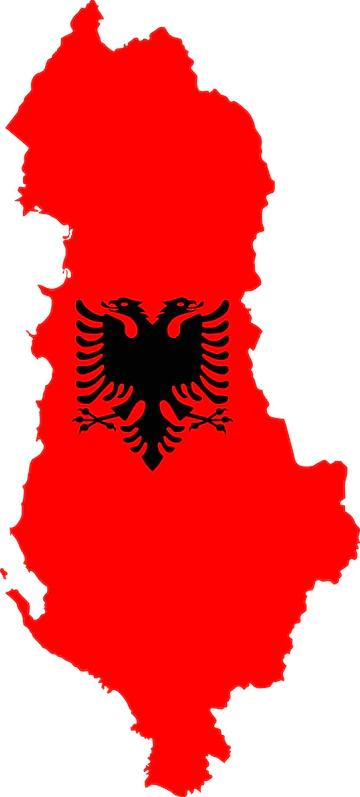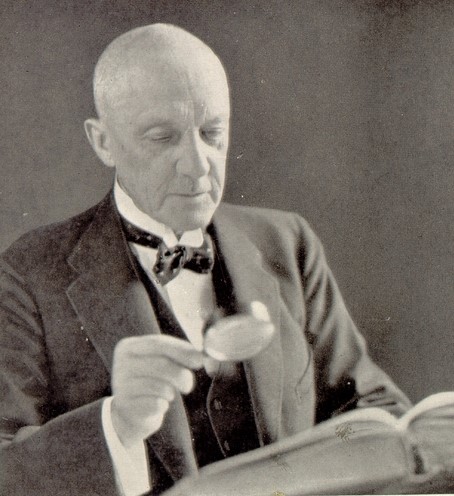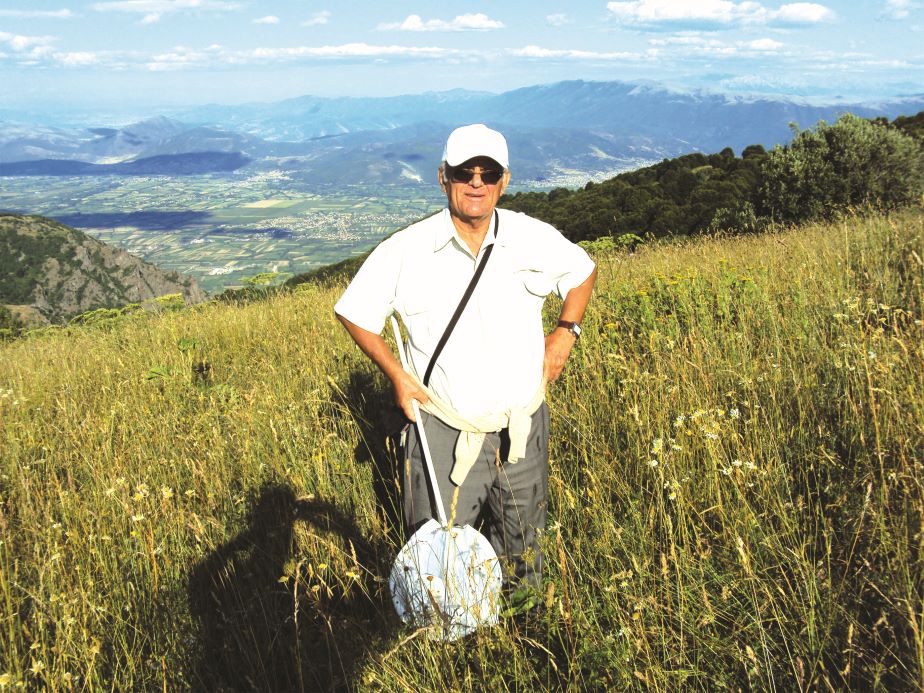Fluturat e Shqipërisë Last update: 09.i.2025 |
 xx xx |
 Tirana University Faculty of Natural Sciences Department of Biology |
|
|
1. Albania Rebel & Zerny (1931) (Fig. 1) were the first to publish a synthesis of personal surveys and data from other researchers including localities of all the observations. At that time, the borders of Albania were different from now. Some localities in this first review article are now situated in the neighbouring countries. For the former Albanian territory this publication mentioned 172 species.
1. Dr. Hans Rebel published the first synthesis for the Albanian butterflies (source) In Warren (1936) confirmation was given for three Erebia species: Erebia medusa ([Denis & Schiffermüller], 1775), E. oeme (Hübner, 1804) and E. gorge (Hübner, 1804). In 1959, Moucha visited Albania and published (Moucha 1963), his observations mentioning the localities. No new species for the country were included. In 1961 a new expedition to Albania was organised by a German team. The results were partly published by Alberti (1965) for the Hesperiidae and by Popescu-Gorj (1971) for the genus Erebia. These articles do not include new species for Albania. A first checklist, unfortunately without details about localities, was published by Murraj (1972) mentioning 93 species. After a first correction, the list contains only 92 species as Pararge anthe and P. bresseis are different names for the two sexes of Chazara briseis (Linnaeus, 1764) and these were included as two different species. Rebel (1903) and Rebel (1917) were cited but Rebel & Zerny (1931) apparently was not available to this author as it was not included in the bibliography. The following taxa were cited for the first time for Albania: Limenitis camilla, Melitaea maturna, M. parthenia, Melanargia lachesis, Satyrus hermione, Pararge alcyone, Coenonympha iphis, Heteropterus morpheus, Pamphila palaemon (Pallas, 1771), Hesperia tessellum and Thecla pruni. At the end of the publication Murraj mentioned that all material, gathered in the “ancient Institut de Sciences” together with material from fieldwork during the years 1958–1964, allowed him to note 82 species, which brings additional confusion to the consistency of this list. Also striking is the fact that some of these species were not included in subsequent local lists (Misja & Kurrizi 1984, Misja 1993 and Misja 2005) without obvious reasons for these omissions. Verovnik & Popović (2013b) included a selection of the taxa in their checklist, some with and others without a specific annotation. Some unexpected identifications can already be adapted and some inconsistencies can be found throughout the article: L. camilla is in fact Limenitis reducta Staudinger, 1901 as can be seen from the figure in Plate 4. Argynnis ino is lacking in the list and not included in a figure but the species was mentioned in the text. Melitaea phoebe was not included in the list but is mentioned in the text and figured in Plate 4. Melanargia lachesis (Hübner, 1790) is in fact a pale M. larissa (Geyer, 1828) figured in Plate 6 and will not be retained in the new checklist. It is also the only citation of this western European species in the literature covering Albania. The other taxa are reviewed in the notes of Cuvelier et al. (2018) where appropriate. The next list was published in 1984 by Misja & Kurrizi and based on the available literature and personal observations, including 180 species for Albania. Cited for the first time were: Spialia sertorius Hffmgg., Colias australis Vrty, Lycaeides idas L., Lysandra Escheri Hbn., Lysandra thersites Cant.-Champ., Agrodiaetus ripartii Frr., Danaus chrysippus L., Limenitis reducta Stgr., Erebia aethiopella Hffmgg., Pseudochazara mamurra H-Sch. and Satyrus actaea Esp. S. sertorius was included as personal observation and also based on literature. However, the citation of Rebel & Zerny (1931) was not well verified: “Sicher unrichtige Angabe, da die Art nach Warren östlich der Adria fehlt.” Furthermore, it is striking that Spialia orbifer (Hübner, 1823) was not included in this list, adding doubts about the identification of the Spialia specimens. C. australis, now Colias alfacariensis Ribbe, 1905, was mentioned for the first time from Albania and Misja mentioned not having observed Colias hyale (Linnaeus, 1758) himself, but it remained in their list, based on Rebel & Zerny (1931). E. aethiopella was cited because it was listed in Rebel & Zerny (1931) as Erebia rhodopensis Nicholl, 1900 from Kobilica, a locality in the Šar Planina and now outside the current Albanian territory. Pseudochazara mamurra H.-Sch. was mentioned from Qafa e Qarrit (Korçë) and was observed on 5.ix.1979. This identification needs to be evaluated in the light of former taxonomy and was reviewed in a note by Cuvelier et al. (2018). For the first time Satyrus actaea (Esper, 1781), a western European species, was unexpectedly reported from different localities and was listed together with Satyrus ferula (Fabricius, 1793). Luquet & Misja (1989a) presented more observations of Danaus chrysippus (Linnaeus, 1758) and the same authors (1989b) recorded a spectacular aberration of Melitaea didyma (Esper, 1778). Gaskin (1990) provided new data from a survey during the first week of September 1988. He recorded 27 species. No new species for Albania were found. He correctly mentioned Pontia edusa (Fabricius, 1777) for the first time from Albania instead of Pontia daplidice (Linnaeus, 1758) and Hipparchia syriaca (Staudinger, 1871) that had been listed in previous articles as Hipparchia alcyone ([Denis & Schiffermüller], 1775) or Hipparchia hermione (Linnaeus, 1764). The confusion and lack of evidence-based documentation concerning H. fagi/H. syriaca can be found in later publications. After the congress “le 5e Congrès International sur la Zoogéographie et l’Ecologie de la Grèce et des régions avoisinantes” in Iraklio, Misja (1993) published an important article that has often been overlooked. It included personal observations, data from Rebel & Zerny (1931) and Moucha (1963) mentioning 181 species for Albania. Three species (names as in the publication) are new for the country: Elphinstonia charlonia Donz., Pseudochazara graeca Stgr. and P. cingovskii Gross. All three are discussed in detail in Cuvelier et al. (2018). Beshkov (1994) and Beshkov & Misja (1995) added further support for species that were already known for Albania. Beshkov (1995) was the first to report Muschampia proto (Esper, [1808]) and Hipparchia volgensis delattini Kudrna, 1975 following dissection of male and female genitalia. He also confirmed H. syriaca including photographs of male and female genitalia in the publication. Abadjiev & Beshkov (1996a) brought the first evidence for Hipparchia senthes (Fruhstorfer, 1908). They confirmed Pieris krueperi Staudinger, 1860 and Gonepteryx farinosa (Zeller, 1847) after more than 60 years. Beshkov & Abadjiev (1996), Abadjiev & Beskhov (1996b) and Beskhov (1996) gave further support for species that were already known for Albania. In van Swaay & Warren (1999) a new synthesis for Albania was presented. Compiler for Albania was Prof. K. Misja (Instituti i Kërkimeve Biologjike, Tiranë). The list included Carcharodus baeticus (Rambur, 1839), Pyrgus bellieri (Oberthür, 1910), Nymphalis vaualbum (Denis & Schiffermüller, 1775), Coenonympha tullia (Müller, 1764) and Satyrium pruni (Linnaeus, 1758). S. pruni was even given a 5–15% distribution in Albania but has only been listed once by Murraj (1972). Some ubiquitous species like Colias croceus (Fourcroy, 1758), Vanessa atalanta (Linnaeus, 1758), V. cardui (Linnaeus, 1758), Lasiommata maera (Linnaeus, 1758) and Coenonympha pamphilus (Linnaeus, 1758) were lacking despite being well reported in earlier publications. In Misja (2003), data were given for the prime butterfly areas in Albania and include localities of Parnassius apollo (Linnaeus, 1758), Euphydryas aurinia (Rottemburg, 1775), Lycaena ottomanus (Lefèbvre, 1830) and Phengaris arion (Linnaeus, 1758). The publication by Misja (2005) (Fig. 2) was the first publication that included dot distribution maps for all species. This book is no longer on the market, very difficult to obtain and by consequence it has not been cited in several articles since its publication in 2005. Different details were striking: S. sertorius was again included and figured and S. orbifer is lacking. Tarucus theophrastus (Fabricius, 1793) was not mentioned in the list but it was described (p. 91), figured (Table 12) and mapped on page 219. Euphydryas maturna (Linnaeus, 1758) was described and figured based on museum specimens. In the summary (p. 39) Erebia arvernensis (Oberthür, 1908) was included but in the text and in Table 21 it was replaced by Erebia tyndarus (Esper, 1781). Hipparchia alcyone ([Denis & Schiffermüller], 1775), H. fagi (Scopoli, 1763) and H. semele (Linnaeus, 1758) were included. Also S. actaea was again included in the list, the text and Table 24. The figures of S. actaea are indeed suggestive for this species. Tracing back this material for elucidation is discussed in the notes of Cuvelier et al. (2018). 2. Prof. Kastriot Misja, researcher in the field and author of the book Fluturat e Shqipërisë (© AP, Striniqi-Laçej (2008) described the threatened insects in the area of Shkodra and Malësia e Madhe. No new species were included. For a few species the changes in taxonomy were not applied and some were cited from places and habitats that are unexpected or not precisely cited: Carcharodus floccifera (Zeller, 1847) at Tarabosh, Spialia phlomidis (Herrich-Schäffer, 1845) from Tarabosh (Shkodër), Pieris krueperi (Staudinger, 1860) from Shirokë, one of the citations for Erebia pronoe (Esper, 1780) from Taraboshi (Shkodër) and one Erebia melas (Herbst, 1796) from Shirokë (Shkodër). Płóciennik et al. (2009) mentioned a few observations of butterflies confirming known species. Eckweiler (2012) reported his observations of Pseudochazara mamurra amymone Brown, 1976 and P. mniszechii tisiphone Brown, 1980 in Albania. Unaware of earlier articles he stated “… found in Albania for the first time” for P. amymone and “… “also found in Albania for the first time” for P. tisiphone. Striniqi-Laçej & Misja (2012) and Striniqi-Laçej & Misja (2013) provided an overview of the threatened entomofauna of northern Albania. No new species were included. Referring to our comment above, concerning the article from Striniqi-Laçej (2008) it is unclear why some of the data were not repeated. For this additional reason, some data in Striniqi-Laçej (2008, 2012 & 2013) need to be interpreted with caution. Verovnik & Popović (2013a) mentioned three new species for Albania: Colias aurorina Herrich-Schäffer, [1850], Pieris balcana Lorković, 1970 and A. iris (Linnaeus, 1758). Erebia rhodopensis Nicholl, 1900 was mentioned from the Albanian side of Mali i Gramozit, thus representing a new species for the current Albanian territory. Verovnik & Popović (2013b) published a new checklist. They included personal observations and available literature with important updates, radical amendments and the much needed taxonomical adaptations. 196 butterfly species were reported for Albania. Annotations were included for: Pyrgus alveus (Hübner, 1803)/P. bellieri, Spialia orbifer /S. sertorius, Muschampia tessellum (Hübner, 1803), Carterocephalus palaemon (Pallas, 1771), Heteropterus morpheus (Pallas, 1771), Pontia edusa (Fabricius, 1777) / P. daplidice, C. hyale / C. alfacariensis, Lycaena candens (Herrich-Schäffer, 1844) / L. hippothoe (Linnaeus, 1761), Aricia artaxerxes (Fabricius, 1793), Polyommatus eros (Ochsenheimer, 1808), Melitaea aurelia Nickerl, 1850, H. syriaca / H. alcyone / H. hermione, H. semele / H. volgensis (Mazochin-Porshnjakov, 1952) /H. senthes, P. mniszechii, P. amymone, Erebia cassioides (Reiner & Hochenwarth, 1792) and Coenonympha rhodopensis Elwes, 1900 / C. tullia. The authors also excluded some species mentioned from previous publications: M. lachesis, S. actaea, Euchloe penia (Freyer, 1851) and N. vaualbum (Denis & Schiffermüller, 1775). A. artaxerxes was confirmed from Mali i Gramozit. Unfortunately, two publications (Misja 1993, 2005) were not available to prepare this checklist. As a consequence, different statements lack relevant data from these two references. Some data were included from old publications, including places that are located outside the current Albanian territory. This was not taken into account for different species by the authors. Comments about such issues are given in Cuvelier et al. (2018). In a review article about E. medusa, Aislteitner (2013) mentioned some observations from northern Albania. In 2014, Verovnik et al. provided more data on the distribution of P. amymone in southeastern Albania and Melovski presented research on the diversity of the butterflies in the Albanian part of the Prespa National Park. In 2015, Cuvelier & Mølgaard (2015) described the variability and the androconial scales of Albanian P. amymone and P. tisiphone. Sachanowicz et al. (2016) reported their surveys and added two new species: Melitaea diamina (Lang, 1789) and Cacyreus marshalli Butler, 1898. They provided a new locality for A. damone and confirmed C. aurorina, P. balcana and A. metis. In 2017, Aistleitner confirmed C. orientalis from northern Albania and in 2018, Vrezoni et al. published research on M. galathea. In the review article of Cuvelier et al. (2018), three new species were reported for Albania: Pyrgus andromedae (Wallengren, 1853), Colias caucasica Staudinger, 1871 and Leptidea juvernica Williams, 1946. Based on the analysis of all historical publications and these recent discoveries a new checklist was presented. Striniqi-Laçej & Misja (2019) confirmed previous data from the Shkodra Lake area. Boshinovska et al. (2020) gave an overview of the butterfly diversity in the Prespa region of North Macedonia, Albania and Greece and confrimed the results from Melovski (2014). Beshkov et al. (2021) figured Erebia gorge albanica Rebel 1917, Erebia medusa ([Denis & Schiffermüller], 1775) and Coenonympha orientalis Rebel, 1910. Dapporto et al. (2022) also used data from Albania in the Atlas of mitochondrial diversity of Western Palearctic butterflies. Cuvelier, Parmentier, Qirinxhki & Paparisto (2023) publish a new update and checklist. |

